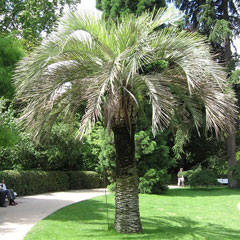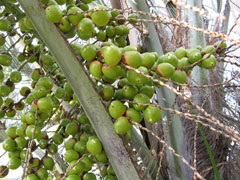 |
|
http://commons.wikimedia.org/wiki/User:William_Avery |
 |
| http://commons.wikimedia.org/wiki/User:KENPEI |
Translate this page:
Summary
Physical Characteristics

 Butia capitata is an evergreen Tree growing to 6 m (19ft) by 4 m (13ft) at a slow rate.
Butia capitata is an evergreen Tree growing to 6 m (19ft) by 4 m (13ft) at a slow rate.
See above for USDA hardiness. It is hardy to UK zone 10. It is in leaf all year. The species is monoecious (individual flowers are either male or female, but both sexes can be found on the same plant).
Suitable for: light (sandy), medium (loamy) and heavy (clay) soils and prefers well-drained soil. Suitable pH: mildly acid, neutral and basic (mildly alkaline) soils. It can grow in semi-shade (light woodland) or no shade. It prefers moist soil.
UK Hardiness Map
US Hardiness Map
Synonyms
Cocos capitata. C. coronata.
Plant Habitats
Woodland Garden Sunny Edge; South Wall. By. West Wall. By.
Edible Uses
Edible Parts: Fruit Oil Stem
Edible Uses: Oil
Fruit - raw[61, 105, 177]. Sweet and aromatic with the flavour of apricots[183, K]. They can also be made into jellies, jams, pies, cakes etc[183]. The fruit is very fibrous but is also very nice[K]. The fruit is about 34 x 25mm[200]. The seed contains up to 45% of an edible oil, it is used mainly for margarines[2, 46, 61, 74]. The pith of the stem can be made into a bread[2]. However, because the tree cannot make side branches this will effectively kill it[K].
References More on Edible Uses
Medicinal Uses
Plants For A Future can not take any responsibility for any adverse effects from the use of plants. Always seek advice from a professional before using a plant medicinally.
None known
References More on Medicinal Uses
The Bookshop: Edible Plant Books
Our Latest books on Perennial Plants For Food Forests and Permaculture Gardens in paperback or digital formats.

Edible Tropical Plants
Food Forest Plants for Hotter Conditions: 250+ Plants For Tropical Food Forests & Permaculture Gardens.
More

Edible Temperate Plants
Plants for Your Food Forest: 500 Plants for Temperate Food Forests & Permaculture Gardens.
More

More Books
PFAF have eight books available in paperback and digital formats. Browse the shop for more information.
Shop Now
Other Uses
Oil
None known
Special Uses
References More on Other Uses
Cultivation details
Succeeds in most fertile moist but well-drained soils in a sheltered sunny position[188, 200, 231]. Tolerates light shade[188]. This plant is not very cold-hardy in Britain but it tolerates short-lived frosts down to about -2°c and can be pot-grown taking the pot outdoors in the summer and keeping it in a conservatory during the winter[200]. It might succeed outdoors in a selected site in the very mildest areas of the country[200]. There are several mature specimens in south-west Cornwall that were planted in the early 1900's[231]. Palms usually have deep penetrating root systems and generally establish best when planted out at a young stage. However, older plants are substantially more cold tolerant than juvenile plants[231]. In areas at the limit of their cold tolerance, therefore, it is prudent to grow the plants in containers for some years, giving them winter protection, and only planting them into their permanent positions when sheer size dictates[231]. Palms can also be transplanted even when very large. Although the thick fleshy roots are easily damaged and/or desiccated, new roots are generally freely produced. It is important to stake the plant very firmly to prevent rock, and also to give it plenty of water until re-established - removing many of the leaves can also help[231]. A slow-growing plant[231], it is occasionally cultivated for its edible fruit and seed[61].
References Carbon Farming Information and Carbon Sequestration Information
Temperature Converter
Type a value in the Celsius field to convert the value to Fahrenheit:
Fahrenheit:
The PFAF Bookshop
Plants For A Future have a number of books available in paperback and digital form. Book titles include Edible Plants, Edible Perennials, Edible Trees,Edible Shrubs, Woodland Gardening, and Temperate Food Forest Plants. Our new book is Food Forest Plants For Hotter Conditions (Tropical and Sub-Tropical).
Shop Now
Plant Propagation
Seed - best sown as soon as it is ripe in a warm greenhouse at not less than 24°c[188]. Stored seed is very slow to germinate. Pre-soaking the seed for 24 hours in warm water prior to sowing may shorten the germination time. Plants form a long tap-root some time before forming a shoot. Germination of fresh seed usually takes place in 3 - 4 months at 25°c[138]. Plant out into individual pots either as soon as root growth is noticed or as soon as top growth appears. Grow on in a greenhouse for at least the first winter. See Cultivation notes above regarding planting them outdoors.
Other Names
If available other names are mentioned here
Native Range
SOUTHERN AMERICA: Brazil (Bahia, Goiás, Minas Gerais)
Weed Potential
Right plant wrong place. We are currently updating this section.
Please note that a plant may be invasive in one area but may not in your area so it's worth checking.
Conservation Status
IUCN Red List of Threatened Plants Status :

Growth: S = slow M = medium F = fast. Soil: L = light (sandy) M = medium H = heavy (clay). pH: A = acid N = neutral B = basic (alkaline). Shade: F = full shade S = semi-shade N = no shade. Moisture: D = dry M = Moist We = wet Wa = water.
Now available:
Food Forest Plants for Mediterranean Conditions
350+ Perennial Plants For Mediterranean and Drier Food Forests and Permaculture Gardens.
[Paperback and eBook]
This is the third in Plants For A Future's series of plant guides for food forests tailored to
specific climate zones. Following volumes on temperate and tropical ecosystems, this book focuses
on species suited to Mediterranean conditions—regions with hot, dry summers and cool, wet winters,
often facing the added challenge of climate change.
Read More
Expert comment
Author
(C.Mart.)Becc.
Botanical References
200
Links / References
For a list of references used on this page please go here
Readers comment
© 2010, Plants For A Future. Plants For A Future is a charitable company limited by guarantee, registered in England and Wales. Charity No. 1057719, Company No. 3204567.